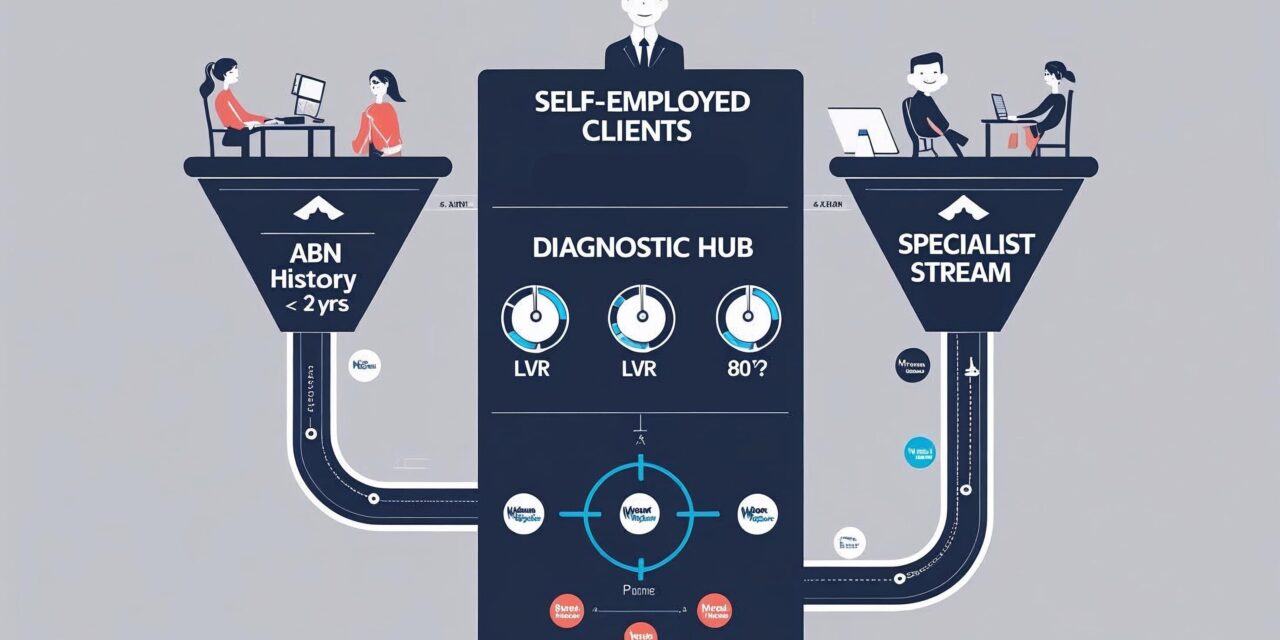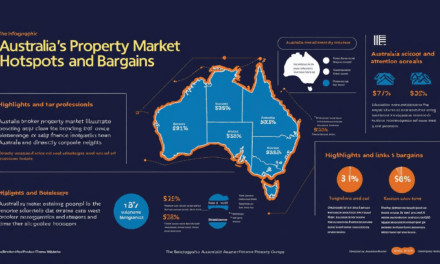Too Busy to Read? We’ve Got You.
Get this blog post’s insights delivered in a quick audio format — all in under 10 minutes.
This audio version covers: The Self-Employed Boom: A Broker’s Deep Dive into Westpac and NAB’s New Policies
The Self-Employed Lending Shake-Up
Your Visual Guide to the New Policies from Westpac & NAB
A Booming Market Lenders Can’t Ignore
Self-Employed Australians
YoY Lending Growth (Westpac)
Quarterly Self-Employment Income
This rapid growth has forced major banks to rethink their approach, simplifying policies to capture a larger share of this lucrative market.
Policy Deep Dive: Westpac vs. NAB
While both banks have introduced one-year income assessments, their strategies and ideal clients differ significantly.
Westpac’s Playbook
The Goal: Reduce paperwork for established, low-risk clients.
- Policy: “1-Year Assessment” option.
- LVR Limit: Strictly 80% or less (No LMI).
- Trading History: Minimum 2 years required.
- Best For: The established sole trader with a 20%+ deposit and a recent high-income year.
NAB’s Strategy
The Goal: Capture the entire banking relationship of high-value professionals.
- Policy: “1-Year Financials” integrated with business banking.
- Key Perk: Expanded LMI waivers for professionals up to 90% LVR.
- Process: Digital-first forms and bundled home/business loan applications.
- Best For: The self-employed professional with a smaller deposit who can leverage the LMI waiver.
The Full Spectrum: Majors vs. Specialists
The majors’ new policies are a huge step forward, but specialist lenders still hold a crucial advantage in flexibility.
Key Specialist Advantages
Specialists cater to scenarios the majors’ streamlined policies still exclude.
-
✓
Short ABN History
Accepting clients with as little as 6 months of trading history.
-
✓
True Alt-Doc
Using BAS, bank statements, or an accountant’s letter instead of full tax returns.
-
✓
Broader Risk Appetite
Greater flexibility for complex structures, credit blemishes, and higher LVRs.
The Broker’s Playbook: A 3-Step Client Triage
Use this decision tree to quickly determine the right lending stream for your self-employed clients.
1. ABN History
Has the client been trading for at least 2 full years?
2. Loan-to-Value Ratio (LVR)
Is the LVR 80% or less? (Or do they qualify for an LMI waiver?)
3. Documentation
Can they provide a full, lodged tax return for the last financial year?
ANY “NO”
Direct to Specialist Stream for flexible solutions.
ALL “YES”
Proceed to Prime Major Bank Stream for 1-year policies.
The Self-Employed Boom: A Broker’s Deep Dive into Westpac and NAB’s New Policies
The Australian economic landscape is undergoing a significant transformation, marked by the rise of the entrepreneur, the freelancer, and the small business owner. For mortgage brokers, this shift presents both a lucrative opportunity and a familiar challenge. The self-employed client segment, now numbering over two million individuals, has long been a cornerstone of the Australian workforce, yet it remains a market that many traditional lenders have historically deemed “underserved”.
However, the ground is now decisively shifting. In a landmark development, two of Australia’s major banks, Westpac and NAB, have rolled out significant policy changes aimed squarely at this burgeoning market. This is not a series of minor tweaks but a calculated strategic response to undeniable market forces. This deep dive will equip brokers with the intelligence needed to find the true best-fit solution for every self-employed client, solidifying their role as indispensable advisers in an increasingly competitive market.
In This Deep Dive
Part 1: Westpac’s New Playbook: Deconstructing the 1-Year Income Policy
Westpac’s recent policy announcement has sent a clear signal to the market: it is serious about reducing friction for self-employed borrowers. The bank is responding directly to feedback from business owners who find the traditional loan process burdensome, aiming to help them “focus on the work, not the paperwork”.
The Headline Change Explained
The centerpiece of Westpac’s new strategy is the “1-Year Assessment” option. This policy is designed to halve the primary documentation burden, reducing the requirement for two years of financial records down to just one. More strategically, this approach allows for an assessment based on the most recent year of income, which can provide a much clearer and more favorable representation of a business’s current performance and borrowing capacity—a crucial advantage for clients whose businesses are on a strong upward trajectory.
The Fine Print: Documentation & Eligibility
To qualify for the 1-Year Assessment, an applicant must provide the most recent single year’s business and personal tax returns (sole traders need only personal returns), the corresponding ATO Notice of Assessment (NOA), and a statement of business liabilities.
Key Eligibility Rules:
- Minimum Trading History: Applicants must still have been self-employed for a minimum of two full financial years.
- LMI is a No-Go: The policy is not available for applicants requiring Lenders Mortgage Insurance (LMI), restricting it to clients with a Loan-to-Value Ratio (LVR) of 80% or less.
- No Complex Structures: Clients with complex business structures or income from multiple self-employed businesses are ineligible.
Contextualizing the Full Westpac Menu
To provide complete market intelligence, it is vital to see the 1-Year Assessment not in isolation, but as one part of a broader, tiered strategy for self-employed lending. Westpac now offers three distinct pathways:
| Assessment Pathway | Ideal Client Profile | LVR Limit | Key Documentation Required |
|---|---|---|---|
| Fast Track | Self-employed with simple income (e.g., PAYG from own company) and substantial equity. | ≤80% | Last 2 years’ personal ATO Notices of Assessment (NOAs) only. No business financials needed. |
| 1-Year Assessment | Established business (2+ years trading) with strong recent performance and sufficient equity. | ≤80% | 1 year’s full business & personal tax returns, personal NOA, and business liabilities. |
| Standard 2-Year | Complex structures, multiple business incomes, or requires LMI. | >80% (or as applicable) | 2 years’ business & personal tax returns, personal NOA, and 2 years’ business financial statements. |
Part 2: Decoding NAB’s Strategy: The Business Bank Plays its Hand
While Westpac’s move is a significant product enhancement, NAB’s approach is rooted more deeply in its core identity as “Australia’s largest business bank”. Their strategy appears less about a single product and more about creating an integrated ecosystem for the business-owner client.
The Core Policy: More than Just a Home Loan Tweak
Like Westpac, NAB has confirmed it will accept “a true one-year tax return for self-employed customers, or one-year of financials supported by tax returns”. However, the implementation and surrounding features suggest a different strategic intent. For its NAB Business Options Loan, which offers lending up to $2 million, the bank has introduced “self-declaring financials via a digital form” based on 12-month financials, suggesting a more modern workflow.
The Power of the Package: LMI Waivers and Bundling
The true competitive strength of NAB’s offering lies not just in the one-year income verification but in the powerful ecosystem of products and policies that surround it.
- Expanded LMI Waivers: In a highly strategic move, NAB has expanded its Lenders Mortgage Insurance (LMI) waiver policy to a broader range of professions, including solicitors, barristers, actuaries, and accountants. This is a potent niche, as many of these professionals are self-employed.
- Integrated Lending: NAB actively encourages the bundling of residential and business lending. Brokers can use the ApplyOnline platform to submit a combined application for both home and small business loans.
| Feature | Westpac | NAB |
|---|---|---|
| Stated Policy | “1-Year Assessment” for home loans. | “1-Year Financials” for self-employed customers. |
| Documentation Process | Traditional document submission (e.g., PDFs of tax returns, liabilities). | Digital self-declaration forms available for business loans up to $2M. |
| Key Differentiator | Simplicity and paperwork reduction for established, low-risk sole traders and simple companies. | Integrated business/home lending ecosystem and targeted LMI waivers for professionals. |
| Ideal Niche Client | A builder with 5 years of history, a clean record, and a 25% deposit, seeking maximum borrowing power based on a strong recent year. | A self-employed accountant with 15 years of history needing an 85% LVR loan, who can benefit from the LMI waiver and potentially consolidate business debt. |
Part 3: The Critical Comparison: How the Majors Stack Up Against the Specialists
While the moves by Westpac and NAB are significant, they are entering a field long dominated by specialist and non-bank lenders. For years, brokers have turned to these institutions for their flexibility, speed, and willingness to assess applications that fall outside the rigid criteria of the major banks.
The Specialist Advantage: A Deep Dive into Flexibility
- Speed to Market (Short ABNs): While Westpac and NAB still generally require a two-year trading history, specialist lenders are far more accommodating to newer businesses. Pepper Money, for example, allows for applications with just six months of ABN and GST registration.
- True Alternative Documentation (Alt-Doc): For the majors, “one-year financials” still means a full, lodged tax return. Specialist lenders like La Trobe Financial and Liberty Financial can verify income using an accountant’s letter, a series of Business Activity Statements (BAS), or business bank statements.
- Broader Risk Appetite: Non-bank lenders are not regulated by APRA in the same way as banks and are not bound by the same mandatory 3% serviceability buffer. This gives them greater flexibility in credit assessment.
| Feature | Majors (Westpac/NAB) | Specialists (e.g., Pepper, Liberty, La Trobe) |
|---|---|---|
| Minimum ABN/Trading History | Typically 2+ years required for eligibility. | From 6 months (e.g., Pepper Money). |
| Income Verification | Latest 1-2 years’ full, lodged tax returns are the primary document. | True Alt-Doc: Accountant Letter, BAS, or Bank Statements accepted. |
| LVR/LMI Approach | Strict ≤80% LVR for simplified 1-year policies; LMI required above this. | Higher LVR options available; may use risk fees instead of traditional LMI. |
| Key Selling Point | Brand trust, extensive branch network, and potentially lower interest rates. | Unmatched flexibility, speed to ‘yes’, and solution-focused approach for non-standard scenarios. |
Part 4: The Broker’s Playbook: A Scenario-Based Guide to Placing Your Next Self-Employed Client
Translating this market analysis into practical, day-to-day strategy is what separates a good broker from a great one. The following scenarios provide a clear playbook for placing the next self-employed client.
Scenario A: The Established Sole Trader with a Bumper Year
The Profile: A plumber, sole trader for seven years, with a significantly higher income in the last financial year. He has a 25% deposit and a perfect credit history.
The Playbook: This client is the bullseye target for Westpac’s 1-Year Assessment policy. A traditional two-year average would unfairly drag down his borrowing capacity. This policy will maximize his borrowing power and simplify the application.
Scenario B: The Recent Start-Up with Strong Cash Flow
The Profile: A marketing consultant who started her business 10 months ago. No lodged tax returns yet, but strong cash flow shown in bank statements. She has a 10% deposit.
The Playbook: An immediate non-starter for the majors’ new policies due to ABN history and LVR. The correct strategy is to engage a specialist lender like Pepper Money, which accepts applications with shorter ABN registration and can use bank statements for income verification.
Scenario C: The Self-Employed Professional with a Low Deposit
The Profile: A partner in an accounting firm, self-employed for 15 years. She is looking to buy with a 15% deposit (85% LVR).
The Playbook: Westpac is out due to the LVR. The optimal play is to use NAB’s expanded LMI waiver for qualified accountants. This secures a loan with a major bank at a competitive rate and avoids the significant cost of LMI, delivering thousands in value to the client.
Conclusion: Your Expertise is the Ultimate Differentiator
The lending environment for Australia’s two million self-employed individuals has fundamentally improved. The strategic entry of major banks with simplified policies is a clear win for many borrowers. However, more choice means more complexity. The era of a one-size-fits-all approach is over.
This new landscape makes the role of a knowledgeable mortgage broker more critical than ever. Your value is in knowing precisely when to use Westpac’s policy, when to leverage NAB’s LMI waiver, and when to bypass the majors entirely for the flexibility of a specialist. Mastering this new, complex landscape is the key to delivering superior client outcomes and winning more business.
Get More InsightsThe Great Divide
A significant and growing gap in loan approval times defines the market. The path a borrower chooses—direct branch or expert broker—can mean the difference between hours and weeks.
Broker Channel Wait Time
0
Median Days
For an unconditional approval via a major bank. Source: MFAA / Connective
Direct Branch Wait Time
0
Days
As claimed by major bank CEOs for proprietary channel approvals. Source: MFAA
A Feature, Not a Bug
This disparity isn’t an accident. It’s a calculated strategy by some major banks to boost profitability by prioritizing their direct channels, creating a two-pronged approach to influence consumer choice.
The ‘Stick’: Degrade Broker Service
By allowing broker channel service levels to lag, banks create friction and frustration. The 23+ day wait time is a strategic lever, not an operational failure, making the broker path appear slow and inefficient.
- ●Increased Friction: Makes the broker value proposition harder to deliver.
- ●Profit Motive: Direct loans are 20-30% more profitable, creating a powerful incentive.
- ●Competitive Disadvantage: Puts broker clients at risk in a fast-moving property market.
The ‘Carrot’: Invest in Direct Tech
Simultaneously, banks are pouring billions into AI and digital platforms to create a seamless, fast, and low-cost direct-to-consumer experience, aiming to lure customers away for good.
- ●AI-Powered Approvals: Automating decisions to promise near-instant service.
- ●Digital Arms Race: Westpac’s “Agentic AI” and CBA’s tech hubs aim to process loans automatically.
- ●Dilute Broker Value: The ultimate goal is to make the broker’s role as a facilitator redundant for many.
The Interactive Lender Landscape
Not all lenders are the same. A new class of ‘broker-centric’ partners consistently deliver speed and service. Use this tool to explore the performance data and identify your true partners.
Lender Details
Click on a lender in the chart to see their performance details here.
Collateral Damage: The Real Cost of Delays
A slow approval isn’t just an inconvenience; it’s a primary risk factor with real human and financial consequences for your clients.
20%
Missed Out on a Property
of borrowers reported losing a property purchase specifically due to a delay in securing full approval, even with a pre-approval in hand.
46
Business Day Nightmare
One loyal 25-year bank customer was quoted a 46-business-day TTT, forcing him to seek an alternative to meet a 21-day settlement.
$77,000
The “Cost of Waiting”
Average additional cost over the life of a loan for a homebuyer delaying their purchase by one year due to market price growth.
The Broker’s Playbook for 2025
Turn the tables on the banks’ strategy. Use your knowledge and these tactics to deliver superior value, protect your clients, and future-proof your business.
Consciously align with broker-centric lenders who deliver consistent service. Curate your panel based on data, not just brand recognition. Prioritize TTTs, BDM support, and clear policy. By directing volume to partners like Macquarie, Bankwest, and ING, you deliver better client outcomes and support a healthier lending ecosystem.
Embrace technology to boost your own efficiency and client experience. Automate low-value tasks to free up time for high-value strategic advice.
- Workflow Automation (BrokerEngine): Reduce the 20+ hours of manual processing time per loan.
- Policy & Serviceability (Quickli): Eliminate hours of research and prevent rework.
- Client Retention (Sherlok): Use AI to proactively analyze your trail book and automate repricing.
- AI Assistants (ChatGPT): Draft emails, create content, and summarize meetings to reclaim your time.
3. Redefine Your Value Proposition
Move beyond being a loan facilitator to become a holistic financial advisor. This is where your true, defensible value lies.
- Diversify Your Services: Expand into commercial, asset, and SMSF lending to deepen client relationships.
- Reframe the Conversation: Shift from a rate-based discussion to one about risk management. Explain how a fast, reliable lender protects the client from financial loss and stress. Use the phrase: “This lender protects you from the $77,000 cost of being delayed.”
- Proactive Communication: Use the TTT gap as a tool. Explain the market dynamics to clients to demonstrate your insider knowledge and justify your strategic recommendations. This builds immense trust and proves your value.






